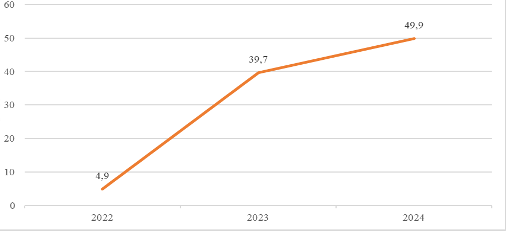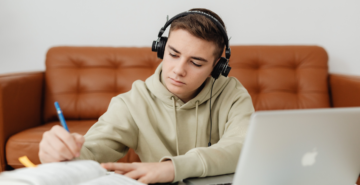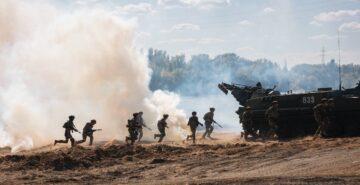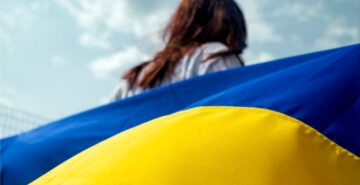

Funding youth policy in Russia through the prism of the war in Ukraine
Author: Tatiana Lychko, documentary at CCE “Almenda”
It has already become clear that Russia uses hybrid methods of warfare and does not disdain to use any means to continue the war for years. This includes not only putting the country’s economy on a war footing, but also preparing a mobilisation reserve of its citizens (and not only, taking into account the total control over Ukrainian citizens in the temporarily occupied territories), paying special attention to young people. To achieve this goal, Russia spares no expense in building an entire system of influence, implemented through the state’s youth policy. Funding for this particular area has increased almost 50 times over the past 10 years, during which the war against Ukraine has been ongoing.
What is the budget amount and where is it spent?
From 2014 to 2018, the budget for youth policy in the Russian Federation ranged from 1.13 billion rubles (equivalent to approximately 12.4 million US dollars) to 18.47 billion rubles (equivalent to approximately 203 million US dollars), and there has been a significant increase since 2021, with expenses of more than 34.3 billion rubles (equivalent to more than 377 million US dollars). As of 2024, more than 56.1 billion rubles (equivalent to more than 617 million US dollars) have been budgeted.


Data taken from the state budgets of the Russian Federation for 2014-2024
The increase in funding since 2021 is likely due to preparations for a full-scale invasion of Ukraine and the need to “properly” prepare young people to accept the Kremlin’s decisions. This also explains the further increase in funding during the years of active military invasion. New tools, such as projects and programmes implemented by a number of government agencies, have been developed to foster a loyal attitude to the authorities and to raise a generation of convenient youth.
The Federal Agency for Youth Affairs
Budget funds allocated for youth policy are managed by the following government agencies: the Ministry of Education of the Russian Federation, the Ministry of Science and Higher Education of the Russian Federation, the Federal Agency for Youth Affairs (Rosmolodezh) and others.
The lion’s share of funding, which is more than 90%, is allocated to Rosmolodezh (official website: https://rs.gov.ru/) – for example, in the current year of 2024, it was allocated more than 54 billion rubles (96% of the youth policy budget). The responsibilities of this institution include:
- implementing measures for civic and patriotic education of young people, fostering tolerance and shaping legal, cultural and moral values among youth, as well as promoting effective forms of youth participation in public life.
- coordinating the activities of the All-Russian public and state movement of children and youth (the “Movement of the First”), which are carried out outside of children’s recreation and health improvement organisations and organisations engaged in educational activities aimed at implementing basic general education programmes and secondary vocational education programmes, including organisations forming the infrastructure of youth policy, cultural and sports organisations and other organisations working with children and youth.
Within the framework of these powers, Rosmolodezh actively develops a network of patriotic clubs and centres, where Russian military personnel involved in the war against Ukraine are engaged as mentors, promoting “the choice of serving the fatherland (Russia) as a lifework”. Rosmolodezh also extends its influence to the temporarily occupied territories of Ukraine (hereinafter referred to as TOT) – a school for leaders and volunteers of the Zaporizhzhia regional branch of the All-Russian public movement “Volunteers of Victory” has been established, where participants will be taught how to properly cover and conduct patriotic actions and events, as well as how to work with (Russian) veterans and pass on their history to young people. After such training, participants can “carry out activities aimed at civil and patriotic education qualitatively and independently”. In fact, personnel are trained to spread Kremlin propaganda and narratives among young people in the TOT.
The Ministry of Education of the Russian Federation
The next largest recipient of state funding for youth policy is the Ministry of Education of the Russian Federation (official website: https://edu.gov.ru/). The increase in its funding occurred in 2021, just before the full-scale invasion, and is related to the implementation of the new federal project «Patriotic Education of Citizens of the Russian Federation».
This project includes:
- developing and implementing operating education programmes in each educational organisation of general and vocational education;
- campaigning and engaging people, including children and youth, to participate in all-Russian, district and interregional patriotic events;
- organising the activities of the patriotic movement of the Association of Student Patriotic Clubs “I AM PROUD”;
Illustrations to the events of the Association of Student Patriotic Clubs “I AM PROUD”
- holding events aimed at popularising the history of Russia in the Russian Federation and abroad;
- involving children in events aimed at educating the younger generation and shaping their personalities, held by regional branches of the Russian movement of children and youth;
- holding the all-Russian competition “BIG CHANGE”;
- involving children in the children’s and youth Military Patriotic Social Movement “Young Army” (“Yunarmiya”);
Team “Alpha” of the Zaporizhzhia branch of “Young Army”
- activities of the historical parks «Russia – My History».


Autonomous non-profit organisations and all-Russian movements
An analysis of federal laws on the state budget of the Russian Federation for the respective year in terms of types of budget expenditure shows that the vast majority of expenditure in the section on “youth policy” is subsidies. That is, managers of budgetary funds not only spend them themselves, but also direct them to recipients, who, in turn, are not always the final link in the chain of budget expenditures, making it difficult to establish the actual budget of specific programmes and all persons involved.
The recipients of some of the largest subsidies under the youth policy sub-section are autonomous non-profit organisations (hereinafter referred to as ANOs) and all-Russian public organisations:
- ANO “Russia – Land of Opportunity” – established on V. Putin’s initiative on 22 May 2018, is used to implement projects, including those aimed at patriotic education of children and youth, spreading Russian narratives, distorting history, justifying and propagandising war, and Russifying and indoctrinating Ukrainian children from the TOT. The link to the official website of the organisation is https://rsv.ru;
- ANO “Mashuk Knowledge Centre”;
- ANO “Big Change”;
- All-Russian public and state educational organisation «Russian Society «Znanie» – founded in 1947 by dictator Joseph Stalin as a system of organisations fully controlled by the Central Committee of the Communist Party of the Soviet Union that carried out Soviet propaganda under the guise of education, revived by Vladimir Putin in 2015. Since 2021, the society’s funding has increased 20-fold from 100 million rubles a year to 2 billion rubles, which is equivalent to more than 22.5 million US dollars (for more information about «Russian Society «Znanie», see the article by CCE “Almenda”);
- All-Russian public state movement of children and youth «Movement of the First» – a movement that has incorporated the totalitarian features of the Soviet Pioneer and Komsomol movements (for more information about the movement, see the separate article by CCE “Almenda” «Movement of the First» – the new pioneers? The All-Russian movement of children and youth, which is personally managed by Vladimir Putin);
- All-Russian public movement “Volunteers of Victory”.
In the current year of 2024, 20.49 billion rubles are allocated to the «Movement of the First» as part of the federal project “Patriotic Education of Citizens of the Russian Federation” (official website: https://edu.gov.ru/national-project/projects/patriot/), of which 7 billion will be spent on patriotic education of youth, and another 9.58 billion will be used to finance the movement’s regional branches. The budget allocates 20 billion rubles for the work of school advisers on education and interaction with children’s public associations, and 873.8 million rubles for Russian state symbols for schools. 400 million rubles will be spent on “My History” mobile exhibitions, and another 251.1 million on subsidies to the “History of the Fatherland” fund.
In total, the amount of money the Russian Federation will spend on patriotic education in 2024 (49.9 billion rubles) is 10 times higher than the budget expenditure on it in 2022 (4.9 billion rubles). In 2023, the budget allocated 39.7 billion rubles for these purposes (6 billion less than in the following year).


Conclusions
According to the results of sociological surveys, the majority of those who do not support the Kremlin’s policy of military aggression against Ukraine are Russian youth under the age of 29. Therefore, it is not surprising that special attention in patriotic education is directed at this age group. According to the logic of the totalitarian regime of the Russian Federation, disagreement with the actions of the authorities is not patriotic and is subject to “correction”. A tenfold increase in budget funding for youth policy, including patriotic education of citizens in the context of reformatting the budget for military needs, is one of the elements of hybrid warfare, which aims to use all resources to educate a “convenient” generation of young people who will fully and unquestioningly follow all the instructions of the authorities. By replacing critical thinking of adolescents with pseudo-patriotic motivation, Russia is preparing a mobilisation reserve to continue the war in Ukraine and gain numerical superiority on the battlefield. The instruments of implementation are movements and organisations, such as the «Movement of the First» and the militaristic «Young Army», which organise propaganda competitions and events funded by the Russian state budget. By extending its influence to the TOT through these instruments, Russia is Russifying, militarising and indoctrinating Ukrainian children and youth. This is a gross violation of international law, so only international pressure and bringing the perpetrators to justice will make Russia stop it.
The publication was prepared by the Center for Civic Education “Almenda” with the financial support of the Czech organization People in Need Ukraine, as a part of the SOS Ukraine initiative. The content of the publication does not necessarily match their position.



